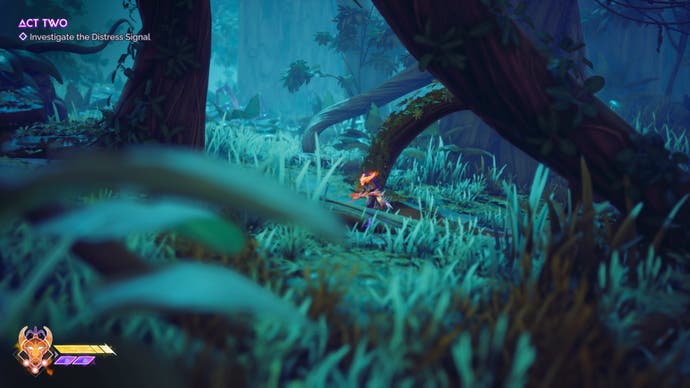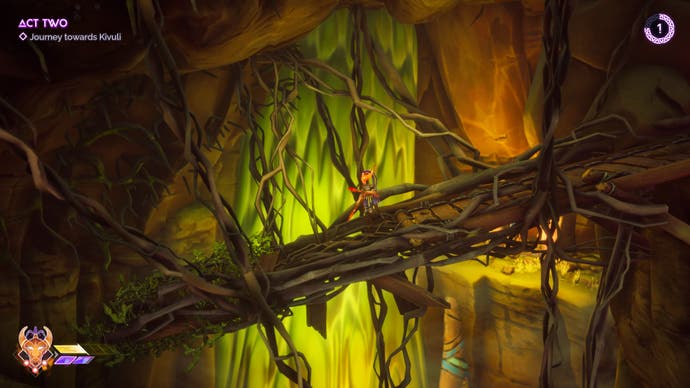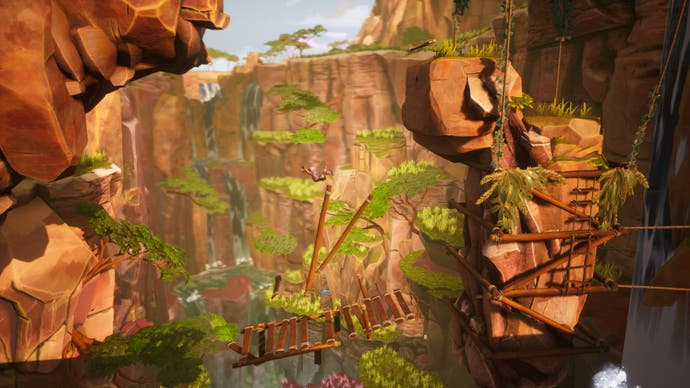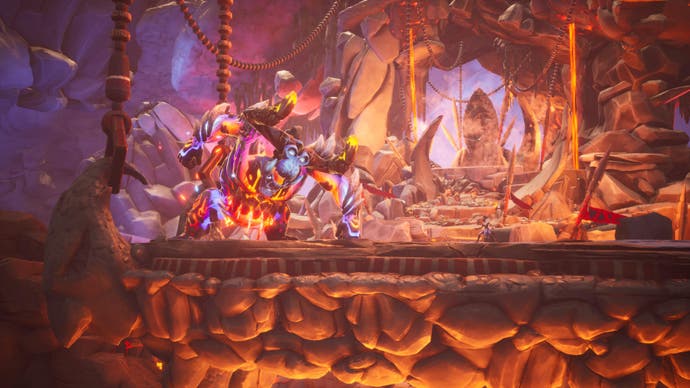Tales of Kenzera review: a compassionate Afro-futurist exploration of grief
Fresh, genuine storytelling.
Of all the Metroidvania elements in Tales of Kenzera: Zau, my favourite are the trees. Simply enough, meditating inside a tree provides a health boost. It's here the camera pans out to reveal these great, almost magical, natural structures which provide safety, sanctuary and a moment of reflection. Protagonist Zau is a hot-headed and petulant young man desperate to revive his father, but sat quietly in the trunk of a tree, he's just a boy.
The trees are a key example of how Tales of Kenzera transposes the genre to its African setting, but also where its heart lies: with the relationship between a father and son. The game's creator, voice actor Abubakar Salim (best known for his portrayal of Bayek in Assassin's Creed: Origins), has been particularly open about the personal inspiration behind the game: his own experience of grief following the death of his father. There's even a moving short film released ahead of the game. Yet even without knowing this, Tales of Kenzera itself exudes passion and love.
It's a story-within-a-story set in the fictional Afro-futurist land of Kenzera, and it tells the tale of desperate shaman Zau who bargains with Kalunga, god of death, following the passing of his father. Zau must deliver three spirits to win back his father and, along the way of his adventure, he learns to cope with his feelings of grief. Kalunga becomes his father-figure guide who speaks in proverbs and commands Zau with stern yet comforting lessons; Zau in return listens, rebels, argues, and accepts.
Back to the trees: it's here we learn more about Zau's relationship with his father. As he reminisces on past moments - the sort you misunderstand as a child but appreciate with the wisdom of adulthood - he recognises the value of these lessons. Zau must learn to let go, and it's by reflecting with Kalunga in these trees he appreciates the extent of his loss and finds hope for the future. Throughout the adventure, Zau wrestles with his feelings and learns to express his emotions as he tackles the issues each of the three spirits represents. Kalunga acts as pseudo-therapist: "I see before me a strong, brave and intelligent young man who chooses to champion hope over despair," he tells Zau at one point.
There's humour too that touches deeper still than sincerity. Kalunga tells Zau of past shamans whose abilities he gradually acquires in typical Metroidvania fashion, yet Zau often laughs in disbelief at the seeming silliness of these stories. These are the Bantu Tales, traditional folk tales from across Africa that Salim shared with his father and directly influence Tales of Kenzera. The narrative often plays on the antagonistic relationship between generations, but it's not hard to picture Salim himself having similar conversations with his own father. He's the voice of Zau and their words are one. Despite the sorrow of its themes, there's an honesty and warmth to the storytelling in Tales of Kenzera that heightens the accomplished, if sometimes rote, gameplay.




If there's one Metroidvania convention Tales of Kenzera gets absolutely right, it's the free flow of movement. Zau begins the game with basic abilities already learned, like a dash and double jump, indicating his base capabilities as a hero. The feel of the game is superb as he swiftly leaps, wall jumps and bounds through each beautiful, African-inspired environment, and later abilities, like a grappling hook and powerful smash, complement the skillset. Narratively these abilities are based on the Bantu Tales, informing both Zau and us of these fantastical, insightful fables - from wrestling with clouds to alleviate drought, to the sacrifice of an elder sister to protect her shaman brother. On a gameplay level, though, they often serve a singular purpose that doesn't creatively push the limits of their function. Take the first ability, for instance, which can freeze water: this allows Zau to run up rivers and wall jump against waterfalls, yet after that initial use the game doesn't build on this in a meaningful way, or combine it with later abilities for more intricate platform-puzzle solving.
Zau also begins the game with his primary combat abilities: two masks, pertaining to the sun and moon, that provide melee and ranged attacks respectively and are switched between at the press of a button. Animations also change depending on the mask worn, from the moon's spiralling gymnastics to the sun's elegant pirouettes. Zau's a capable fighter, then, with attacks building up spirit energy that's used to either heal or unleash powerful blasts of anime-style energy. These are later boosted by unlocks in a simple upgrade tree. Again, it all flows well and feels satisfying at first, but combat is ultimately let down by a lack of enemy types that leads to repeated visual design and strategy, with higher difficulty achieved by simply throwing in more enemies at once. Bosses, though, punctuate story and gameplay with welcome challenge and there are some thrilling chase and escape sequences.


If some of this feels familiar, there are multiple gameplay devices that reveal Salim's gaming influences, from the Gears of War-style reload to prevent spamming shots, to the Ori-esque parrying of projectiles. Another is the trinket system, similar to the badges in Hollow Knight, that provide useful boosts, but their impact is lessened by the need to switch at workbenches that are spread too thinly throughout the map. Tales of Kenzera leans into player expectations of what a Metroidvania should be, resulting in an enjoyable, if straightforward, 2D adventure experience.
Yet I'm not quite convinced it satisfies as a Metroidvania. When I think of the genre, I mostly think of getting lost in labyrinthine worlds and needing to think creatively about my abilities to proceed. This didn't happen to me in Tales of Kenzera, and that's for two reasons. Firstly, the map - itself a little difficult to read between negative space - reveals an area in full at its start, meaning you never get the sense of exploration and discovery as you proceed. Secondly, while the world branches in multiple directions, progression is linear. There are optional areas to delve into to find new trinkets, often with plentiful insta-death hazards (so, so many spikes), but for the most part the main path is clear beyond simple (and literal) keys and locks. Metroid fans expecting an interconnected world of backtracking and disorientation may be left wanting.

Still, while it's easy enough to pick out flaws, they're forgivable due to the game's primary focus on compassionate storytelling, told mostly through expressive artwork. Tales of Kenzera thrives on its authentic African setting and offers vital representation as a result. The care and attention to detail here is clearly apparent, from the integration of the aforementioned Bantu Tales, to the inclusion of a Swahili vocal dub. The game's presentation merges modernity and tradition in a unique global melting pot of ideas. There's Afro-futuristim and folklore in its expansive visual design and intricately detailed costumes and hairstyles, plus anime eccentricity in combat. And its incredible score combines Western orchestration, sci-fi synths and ethnic instruments. I've not played a game like Tales of Kenzera before because this type of setting isn't seen enough in gaming, whether due to under-representation in the industry or perceived lack of interest from players. But these stories deserve to be told and Salim deserves praise for creating a game with a world that feels so fresh and unique.
The games industry needs diverse stories, both to highlight difference and prove their universality. Tales of Kenzera excites with its authenticity, yet its true power lies in its emotive, earnest narrative that tells a father-son story of grief that relates to us all and our hope for the future. As Zau tells Kalunga: "one thing I know about the human spirit is that if there is a chance - even a shred of hope - of potentially making things better, we take it." So reach out and grab it.
A copy of Tales of Kenzera: Zau was provided for review by EA.


.jpg?width=291&height=164&fit=crop&quality=80&format=jpg&auto=webp)

.png?width=291&height=164&fit=crop&quality=80&format=jpg&auto=webp)











